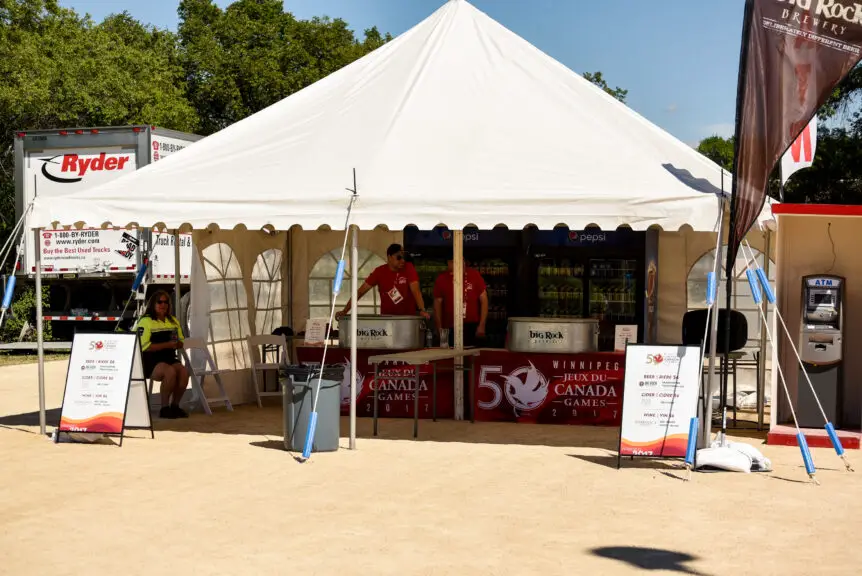6 ways to safely secure your gazebo and stop it from being damaged in high winds

Gazebos are useful structures for all types of occasions and are good for the garden, camping, events, and street food markets.
However, being a temporary structure means they are also prone to damage in bad weather, particularly in windy weather conditions.
It’s therefore important to keep your gazebo secure from wind to avoid damage not only to the gazebo itself but also to people and property.
So how do you secure a gazebo in high winds?
Common ways to secure gazebos from wind include using leg weights, rope and pegs, anchoring kits, polypropylene straps, and threaded rods.
However, the type of surface you pitch your gazebo on can often influence which one of these methods you use.
In this article, I’ve listed 6 ways to secure a gazebo from the wind on both concrete and grass surfaces.
Different surfaces
Depending on what type of surface you intend to set up your gazebo on will often influence what method you use to secure it from the wind.
Concrete
Concrete is a good surface to pitch upon as it is more of a flat and even surface. Common ways to secure it on concrete include gazebo leg weights and polypropylene straps.
Grass
Even though grass surfaces may not be as flat and even as concrete it does offer more ways to secure a gazebo from windy conditions.
In addition to the methods for securing gazebos on concrete surfaces, you can also use pegs and rope, threaded rods, and anchoring kits on the grass.
1. Gazebo weights

Gazebo leg weights offer a very good solution for securing gazebos in high winds and they can be used on any type of surface (concrete or grass).
They come in a number of designs from cast-iron weights that slide over the feet of the legs of the gazebo to sand and water-filled bags that clip onto the legs.
It’s recommended to have between 15- 25kg of weight per leg (60-100kg in total) to keep a gazebo safely secure.
Suitable for: Concrete and grass
You can buy this product from Amazon at the latest price
2. Pegs & Ropes

Ropes and pegs are another common way to stop a gazebo from blowing away on grassy surfaces.
To secure the gazebo push the gazebo stakes into the ground in each of the four corners of the gazebo a couple of metres away.
You can then use a strong rope or a thick cord to thread through the stakes and up to the crossbars of each of the corners of the gazebo’s inner roof.
For extra safety in especially windy conditions, you can also add an extra 4 pegs so you have 8 pegs and ropes in total for all corners and sides of the gazebo.
Suitable for: Grass
You can buy this product from Amazon at the latest price
3. Threaded Rods

If you are looking to have your gazebo as more of a permanent structure and do not intend to take it down very often then threaded rods are a good solution to secure a gazebo in high winds.
To secure effectively you will need to thread 2 rods per leg (depending on the design of the gazebo leg you may need to drill into the feet).
You also have to make sure that the rods are long enough with experts recommending using rods 24in length.
Suitable for: Grass
You can buy this product from Amazon at the latest price
4. Anchoring kits

Anchoring kits are another good way to secure your gazebo and stop it from being damaged in high winds.
Anchoring kits offer a similar way to pegs and ropes but are more secure as the pegs are corkscrewed which makes them harder to be dislodged from the ground.
To safely secure the gazebo screw 4 pegs into the ground for every corner and then feed the straps through the peg loops up to the horizontal bars in the inner roof of the gazebo.
Suitable for: Grass
You can buy this product from Amazon at the latest price
5. Polypropylene Straps

Polypropylene Straps, also known as “ratchet tie-down straps” offer a very good solution for securing your gazebo in high winds.
These straps have a very high breaking point (the product in the image has a 1500lb breaking point) which means the weather has to get pretty severe before your gazebo gets blown away.
And because of the racket function, you can make sure the straps get very tight so you minimize any slack that might cause the gazebo to shake.
However for racket straps to be fully effective there will need to be a heavy fixed structure or steel rings embedded into a concrete surface for the metal hooks to attach to.
Suitable for: Concrete and grass
You can buy this product from Amazon at the latest price
6. Anchor to other gazebos

A final tip that I often use to secure my gazebo from high winds when trading at food markets is to use leg weights and additionally anchor the gazebo to other gazebos or fixed structures.
This can be done with a bungee cord by tying the legs of two gazebos together (good for when there is a gazebo on either side of you).
Suitable for: Concrete and grass
Related articles:
Related questions
Where is the best place to put a gazebo?
The best place to put a gazebo is on an even or flat surface such as a patio or concrete. It also helps if it is placed in a shielded position away from the elements next to buildings, houses or fixed structures.
Gazebo sides up or down in the wind?
When it’s windy keeping the gazebo sides up will help to stabilize the structure as you will not have the “umbrella or up-lift effect” of having the side downs.
However, it all depends on what you are using the gazebo for as items that are not fixed inside of the gazebo will blow away or fall over.
Key takeaway
Where you set up a gazebo to determine which of the 6 ways you use to secure it from the wind.
If you place it on concrete the main way to secure it will be to use gazebo leg weights.
If on the other hand, you pitch up on grass you will have more options to secure it such as pegs and ropes, anchor kits, and threaded rods.
And for extra safety, you can also use a combination of ways to secure your gazebo such as leg weights and anchor kits.
The main thing is that when it’s windy make sure your gazebo is in a secure position.
Gavin D is the founder of Street Food Central and Tru Foo Juice Bar Co. and has worked in the mobile catering industry for over 7 years.

